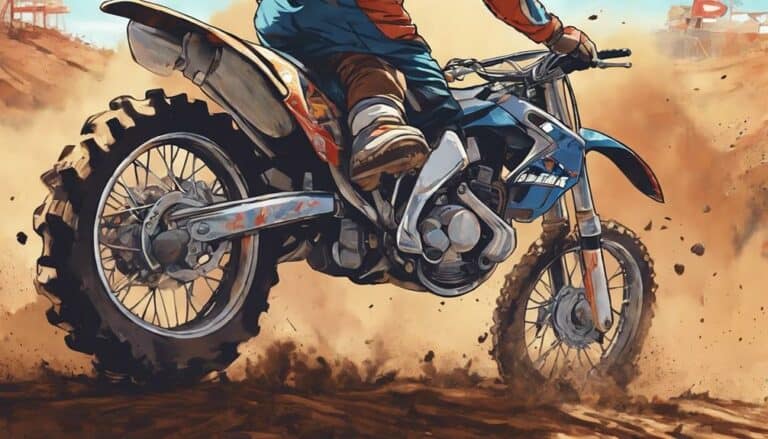When breaking in a dirt bike motor, starting with a methodical approach is key. You've taken the steps to guarantee a proper break-in for your engine, but what comes next is just as vital.
Understanding the nuances of maintaining your dirt bike post-break-in will determine the lifespan and performance of your motor. Let's explore the essential practices and tips that will keep your dirt bike running smoothly and efficiently.
Key Takeaways
- Gradual warm-up and light riding are crucial for new dirt bike engines.
- Monitor oil levels, quality, and filters regularly to ensure proper lubrication.
- Allow the engine to cool completely before maintenance to prevent damage.
- Follow recommended maintenance schedules and procedures for optimal performance.
Importance of Break-In Period
During the break-in period, the vital process of allowing internal components to settle and optimize performance is imperative for the longevity and functionality of your dirt bike motor. When breaking in a new engine, especially the cylinder head, it's critical to follow the proper break-in procedure to guarantee optimal performance.
Riding the bike during this period is necessary, but it must be done with care to avoid overheating the engine. Heat cycles, where the engine is allowed to warm up and cool down properly, are essential for the components to adjust correctly.
Engine rebuilding or installing a new engine also requires a meticulous break-in process to ensure longevity. Changing the oil at the specified intervals during the break-in period is vital to remove any metal shavings or debris that may have accumulated during initial use.
Properly managing the break-in period will set the foundation for a reliable and high-performing dirt bike engine in the long run.
Break-In Procedures for New Dirt Bikes
To properly break in a new dirt bike engine, follow a gradual warm-up, light riding, and avoid high loads to allow internal components to settle. During this critical period, typically lasting around the first 500 miles or 10-20 hours of riding, it's essential to use varying throttle positions, gears, and RPMs to guarantee even heat distribution across the cylinder.
Proper engine break-in also involves using the manufacturer-recommended oil and regularly checking the oil level to maintain ideal lubrication. Additionally, paying attention to the air filter's cleanliness is important for preventing debris from entering the engine during the break-in process.
Monitoring Milestones and Warning Signs
Monitor your dirt bike's oil levels and quality regularly throughout the break-in period to guarantee proper lubrication and engine health. Keeping a close eye on these factors is important for the longevity and performance of your bike.
Here are three key points to remember:
- Check Oil Levels: Make sure the oil level is within the recommended range. Low oil levels can lead to insufficient lubrication, causing potential damage to the engine components.
- Inspect Oil and Oil Filter: Regularly inspect the oil quality and the oil filter. Contaminated oil or a clogged filter can hinder proper engine lubrication, leading to increased wear and tear.
- Listen for Warning Signs: Be attentive to any unusual noises, smoke, leaks, or changes in performance. These could be indicators of issues that need immediate attention to prevent further damage.
Cooling Periods and Maintenance Schedule
Guarantee the engine has completely cooled down before initiating any maintenance checks to prevent potential injuries or damage.
On the first day with your new dirt bike, after the initial break-in period, changing the oil is important.
When the engine is running, monitoring oil levels is a good rule of thumb to make sure proper lubrication. Additionally, keeping an eye on the top end and the torque of cylinder head nuts is essential for preventing leaks and engine issues.
Depending on whether your engine is air-cooled or water-cooled, make sure to employ appropriate cooling methods to maintain best temperature. Regularly checking fluid levels and verifying the torque of cylinder head nuts can help in preventing any loosening that may occur.
Paying attention to these maintenance tasks will contribute to the longevity and performance of your dirt bike.
Post-Break-In Tips and Best Practices
Wondering how to maintain peak performance post-break-in for your new dirt bike engine? After breaking in your motorcycle engine for the first time, it's essential to follow these tips to prevent engine failure and guarantee peak performance:
- Change Oil Regularly: To keep your four-stroke engine running smoothly, make sure to change the oil at regular intervals post-break-in. Fresh oil helps maintain engine lubrication and prevents premature wear and tear.
- Inspect and Clean Air Filter: Proper airflow is essential for your engine's health. Check and clean or replace the air filter as needed to prevent dirt and debris from entering the engine, which could lead to damage.
- Tighten Bolts and Perform Routine Maintenance: Regularly check and tighten bolts to prevent any issues during rides. Performing routine maintenance tasks will help you catch potential problems early and make sure your bike is ready for the next adventure. Remember, a well-maintained bike is a safe bike.
Conclusion
As you finish breaking in your dirt bike motor, remember to keep up with regular maintenance, follow manufacturer guidelines, and monitor the engine for any warning signs.
By staying diligent and attentive, you can guarantee that your dirt bike engine continues to perform at its best, just like a well-tuned racing machine ready to conquer any terrain.
Keep up the good work and enjoy the ride!

